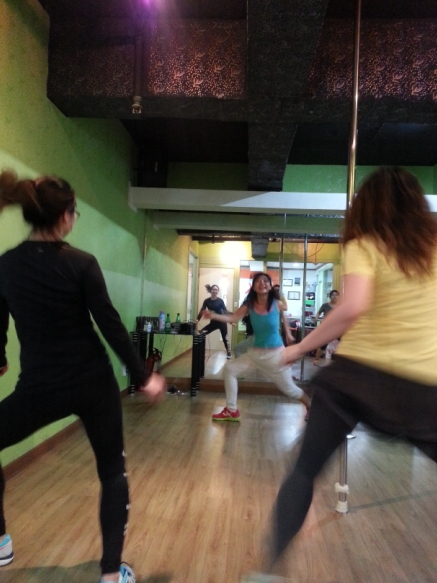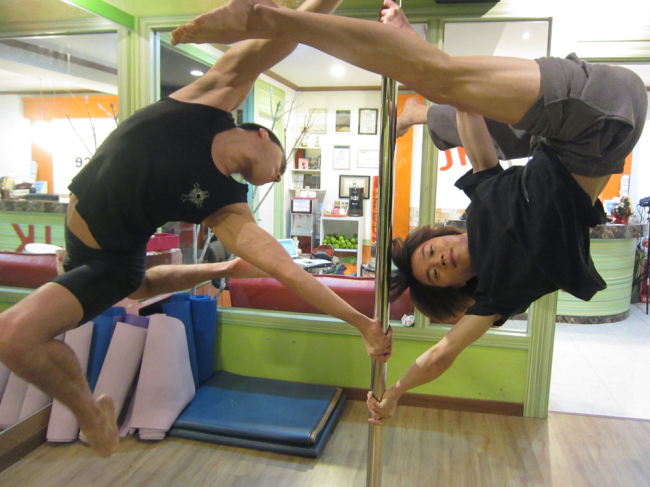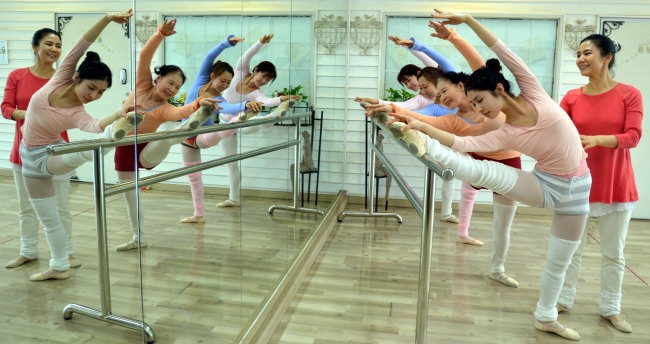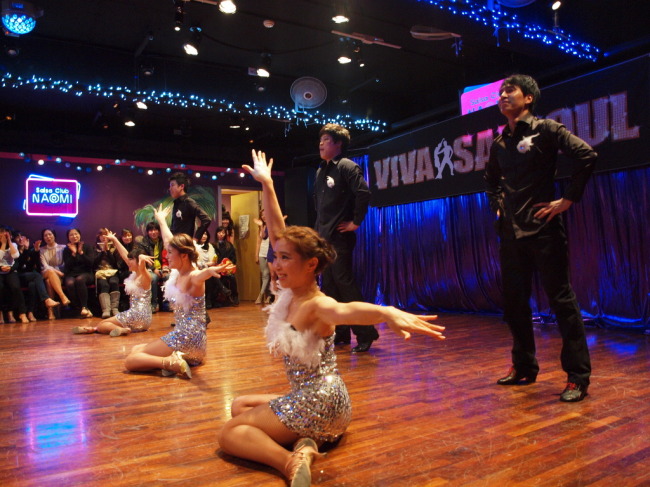[Weekender] Burn calories, build muscle without being stuck in the gym
Zumba, pole dance, ballet and salsa are becoming fun alternatives to treadmills
By Korea HeraldPublished : April 11, 2014 - 20:35
Many 9-to-5ers find it impossible to regularly work out at the gym, although they do want to shed some kilos and stay in shape.
They may be too exhausted from work, or may have health conditions that prevent them from doing weight lifting or sprinting. But in most cases, it is boredom that causes people to avoid regular workouts ― even celebrities such as singer Son Dam-bi and actress Ko Jun-hee publically complain that “gym workouts are ‘boring.’”
The good news is that many forms of dance have been modified to replace gym workouts and allow people to have fun as they exercise.
Zumba
With Zumba, an artful mixture of fitness and dance, one can burn 1,000 calories an hour while dancing to groovy Latin beats. Not many people can shed 1,000 calories in a single gym workout.
The dance combines elements of salsa, merengue, samba, reggaeton and hip-hop with other aerobic exercises. Typical workout moves such as squats and lunges are partially blended into the Zumba moves.
“I usually don’t perspire much, but Zumba has me perspiring and feeling refreshed afterward,” said An Yu-bin, 28, a translator, who takes Zumba classes at JK Dance Studio in Hapjeong-dong, Seoul. “I think I lost some of my abdominal fat,” she added, beaming and laughing triumphantly.
They may be too exhausted from work, or may have health conditions that prevent them from doing weight lifting or sprinting. But in most cases, it is boredom that causes people to avoid regular workouts ― even celebrities such as singer Son Dam-bi and actress Ko Jun-hee publically complain that “gym workouts are ‘boring.’”
The good news is that many forms of dance have been modified to replace gym workouts and allow people to have fun as they exercise.
Zumba
With Zumba, an artful mixture of fitness and dance, one can burn 1,000 calories an hour while dancing to groovy Latin beats. Not many people can shed 1,000 calories in a single gym workout.
The dance combines elements of salsa, merengue, samba, reggaeton and hip-hop with other aerobic exercises. Typical workout moves such as squats and lunges are partially blended into the Zumba moves.
“I usually don’t perspire much, but Zumba has me perspiring and feeling refreshed afterward,” said An Yu-bin, 28, a translator, who takes Zumba classes at JK Dance Studio in Hapjeong-dong, Seoul. “I think I lost some of my abdominal fat,” she added, beaming and laughing triumphantly.

Dancers’ feet hardly touch the ground during Zumba dancing because of the constant motion.
“The great thing about Zumba, besides its massive workout effect, is that it is really meant to let people enjoy themselves and relieve stress,” said Jacey Joo, a Zumba instructor at JK Dance Studio.
“Zumba is great for people of all age because it helps people build up muscles without taxing their joints,” she added.
Zumba Company, the U.S.-based company which created the dance, has “Zumba Kids” programs for children aged 4 and older. The dance is also popular with the elderly, who seek easy, fun group exercise. “As far as I know, the oldest zumba instructor is 70-some years old. Apparently, there is no age limit when it comes to passion for Zumba,” Joo smiled.
The 27-year-old instructor said she suffered from fibromyalgia, a chronic condition that causes widespread pain, which kept her in bed for two full years.
“I was so ill that I couldn’t get out of bed and go to the bathroom ― except when my mother helped me.”
On her sickbed she watched Zumba videos on YouTube, and followed some basic moves. While aerobics with energetic jumping aggravated her pain, Zumba helped her build 2 kilograms of extra muscle, which alleviated the pain and restored her health.
“Zumba really gave me back my life,” the Zumba instructor said.
Pole dancing
Pole dancing combines dance and acrobatic movements around, up and down a vertical pole.
Pole dancers have to use their muscle strength to support their weight on the pole.
“About 15 minutes of pole dancing is equivalent to a one-hour workout at the gym,” said Jang Yeon-ju, 27, a pole dance instructor at JK Dance Studio.
“I had gained 37 kilograms since I became pregnant with my son, but shed 30-32 kilograms through pole dancing,” Jang said.

Beginners are instructed to build enough muscle strength to mount the pole and swing. The first 15 minutes of the lesson is devoted to stretching, followed by pole stretching ― stretching with the pole ― and pole fitness that involves actual pole-dancing techniques.
Pole dance is currently popular among women from their late 20s to mid-30s, while the number of men and women in their 40s is gradually increasing. Beginners who take two sessions a week start to gain attractive curves in three to four months, according to the instructor.
While the dance was once a pastime of celebrities, it has now become a globally popular fitness dance for both men and women.
The bias against pole dance is still prevalent in Korea, making men hesitate to sign up for the classes.
“We get a surprising number of calls from men inquiring (about pole dancing), and yet only a handful actually show up to register,” a JK Dance Studio operator said.
But reviews from male participants are positive.
“Pole dancing is much more effective in building back muscles and six-packs, whereas pilates and yoga are more about stretching,” said Choi Man-joong, a 35-year-old man who takes lessons at JK Dance Studio. The former pro-golfer takes pride in his perfectly toned shape, posting much-admired photos of himself pole dancing on his Kakao Story page.
Ballet
Special ballet programs for nonprofessionals, choreographed by Ballet Na Studio principal Na Sun-young, are largely rehabilitative and aesthetically engaging, designed for laypersons without previous ballet training.
This program is best at building balanced muscles, straightening bent legs and curing chronic pain, according to the former lecturer at Sejong University. The classical music played during the lesson is another great treat for lovers of classical music.

“Ballet is all about perfect posture, balanced muscles, flexibility,” said Na, who started ballet at 5, and has devoted 20 years to teaching her program. “The lesson takers can shed 7-8 kilograms in a healthy way.”
The oldest student in Na’s weekend ballet class in the Hongdae area is Lee Moon-ja, 74, who proudly said she has lost 10 kilograms, going from 58 kilograms to 48 kilograms. She has won the grand prize in several annual competitions for nonprofessional ballet dancers.
“I was almost paralyzed on my right side, and had trouble walking properly with my bent spine for 10 years. I tried attending Korean traditional dance to regain my health but the moves were not appropriate for people like me … it only aggravated my symptoms,” said Lee.
She began taking principal Na’s ballet lessons after her daughter-in-law invited her to the studio. Now the elderly ballerina is mostly free from pain and can make a beautiful turn with her slender, flexible legs.
Another student, Choi Na-hyun, 25, said the ballet program saved her from a painful cervical herniated nucleus pulpusus disk, aka “neck disk.” She said that building up muscle strength was arduous when she began two years ago, but it has given her a lasting cure while the clinical treatment only provided temporary relief.
Considering that only a handful of personal trainers at fitness centers have official rehabilitation instructor licenses, Na’s ballet-for-public programs serve two major purposes; enhancing public health and promoting ballet.
“This special ballet program is an excellent full-body exercise,” Na emphasized, adding that the program straightens bent spines and legs, eases stiff shoulders and stabilizes the respiratory system.
She emphasized that her program is also recommended for children with developmental disabilities, ADHD, autism and other cognitive disorders. She wrote her doctoral thesis on the rehabilitative effect of ballet on such children.
Salsa
Having one of the largest social dance communities globally, salsa originated in New York, and was strongly influenced by Latin America, especially Cuba and Puerto Rico.
The dance gained instant popularity in Korea during the 2002 Korea-Japan World Cup, as the Latin pop song “Livin’ la Vida Loca,” released in 1999 by Puerto Rican singer Ricky Martin, heated up the festive mood.

“It has been 11 years since I began learning salsa in the salsa gathering offered at work,” said Kim Soo-hee, 36, an employee of a tech subsidiary of LG, who takes salsa classes at Salsoul Dance School. “After two to three years, I was so into salsa that I would even dance for five hours in a single day,” she added.
As a combination of aerobic and anaerobic exercise, salsa involves constant fast steps and dance technique. It is a great confidence booster and helps develop exquisite muscles and a beautiful waistline.
“For women, salsa generates gorgeous curves and lifts up the hipline,” said Teresa Eun-kyung Chung, a salsa instructor at Salsoul Dance School, a salsa-intensive dance studio in Gangnam-gu, Seoul.
Chung’s fellow salsa instructor, Jeio Jae-hee Jin, pointed out that the majority of the students were economically active men and women from their 20s to 40s seeking a lifelong alternative to gym workouts.
In Asia, where fewer men take salsa classes than women, Korea boasts one of the highest male participation rates.
“I have been attending salsa classes at Salsoul for the past five years and will keep on dancing as a regular workout-hobby,” said Lee Jae-ho, 34, who works at an auto parts manufacturer. “I get to use muscles, like in the inner thighs, outer calves and buttocks, that I rarely get to use while playing soccer or other ball sports.”
Lee said he keeps his salsa hobby a secret from some elderly people who have the now-obsolete perception that salsa is a tool for seduction among womanizers.
By Chung Joo-won (joowonc@heraldcorp.com)
-
Articles by Korea Herald







![[KH Explains] How should Korea adjust its trade defenses against Chinese EVs?](http://res.heraldm.com/phpwas/restmb_idxmake.php?idx=644&simg=/content/image/2024/04/15/20240415050562_0.jpg&u=20240415144419)












![[Today’s K-pop] Stray Kids to return soon: report](http://res.heraldm.com/phpwas/restmb_idxmake.php?idx=642&simg=/content/image/2024/04/16/20240416050713_0.jpg&u=)